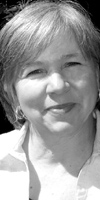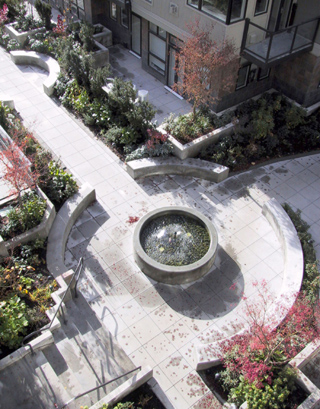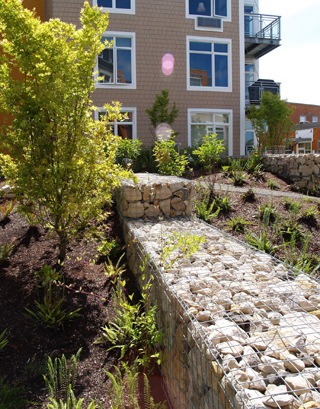
Surveys
DJC.COM
June 26, 2008
Municipalities discover the benefits of eco-roofs
TRA

Martin
|
Over the past few years, there has been a notable increase in demand for eco-roof design, especially within urban landscapes. At TRA, more than half of our urban projects contain structurally integrated landscape. In 2007 alone, we experienced a 14 percent increase in eco-roof projects.
The driving force behind this growth is a combination of the many unique benefits of eco-roofs.
Environment
Both extensive eco-roofs and intensive rooftop gardens are present within our region. Extensive eco-roofs typically contain 4 inches of soil and drought-tolerant, low-maintenance plants such as sedum. Intensive rooftop gardens have planting area depths that range from 8 to 24 inches. Deeper soils can support a greater variety of plants including perennials, shrubs and small trees. Both types of eco-roofs provide environmental benefits, allowing them to absorb heat radiated from the building, reduce stormwater runoff, filter pollutants, absorb carbon dioxide and release oxygen.

Photos courtesy of TRA At the Regata condos in Seattle, concrete and pedestal pavers create the edges for planting areas while form creates circulation and pedestrian spaces. |
Amenity
Eco-roofs are created to provide comfortable social and aesthetic spaces, bringing life to what otherwise were empty, utility-oriented landscapes. By incorporating eco-roofs, new spaces become accessible. They aesthetically improve the appearance of a building to the occupants of surrounding buildings. This could be beneficial to securing a permit for construction in an urban setting.
Eco-roofs create spaces to provide views for people and allow them access to new heights.
Policy

Gabion retaining walls address the stepping of the garage roof deck and walls at the Harbor Square condos on Bainbridge Island. The gabion baskets and rock express a contemporary agrarian fieldstone wall. |
The Green Factor policy adopted on Jan. 20, 2007, regulates new landscaping requirements in Seattle’s neighborhood commercial zones. It was designed to improve the extent and quality of landscapes, focusing on increasing the environmental benefits of these spaces.
Green Factor requires projects in neighborhood commercial zones to contain landscape designs with approximately 30 percent plant coverage on site. The use of eco-roofs is encouraged, as they are acceptable alternatives to reaching Green Factor requirements. At TRA, 91 percent of Green Factor projects have some type of eco-roof, to this date covering more than 48,000 square feet of impervious surface.
LEED is becoming a marketing tool for new development. This green building certification program recognizes eco-roofs (and the benefits received from them) as qualifying for participation in its point-based award system. Apart from the environmental gains of eco-roofs, new construction and major renovations can receive additional credits in subcategories that include reduced site disturbance, improved daylight and natural views, and innovative design.
Seattle Public Utilities is rewriting its stormwater manual to include eco-roofs. It and other organizations are working to further quantify stormwater benefits, allowing city code to credit these new stormwater facilities. To achieve this, SPU is looking to the Western Washington Hydrologic Model to standardize eco-roof modeling.
The Western Washington Hydrologic Model contains monitoring data from Portland and in the near future will include Seattle’s monitoring data. Seattle is in the process of developing technical guidelines for eco-roof construction, helping to further standardize installation practices.
But what else can be done? Ideas can be gained by observing the policies of other municipalities. Incentives found elsewhere include: reduction in water and sewage charges, elimination of stormwater runoff in redevelopments (particularly in areas where drainage systems are at capacity or areas where combined sewer overflows are used), allowance for increased building density, and allotment of grant money to fund eco-roofs.
Design
Every eco-roof design is unique; the key to success lies in finding solutions to benefit each particular client and their project. With each eco-roof design, consideration should be given to its primary function, overall cost, maintenance, location and aesthetic presence. Through eco-roof design, we can create exceptional outdoor environments — venues that expand living spaces and that are environmentally responsive.
Successful projects will play a vital role as we continue to develop new ways of installing structurally integrated landscapes. These projects will be pivotal in the on-going coordination and communication of ideas between disciplines, including civil and structural engineers, building envelope specialists, architects, interior designers and horticulturalists.
At the very basic level, some form of eco-roof system will need to be implemented. It will be our challenge as landscape architects to create spaces that have depth, dimension and dialogue — the 3-D qualities that we cherish in our landscapes on Earth, even with only 4 inches of soil.
Cindy Martin is landscape architect at Thomas Rengstorf Associates (TRA). She graduated from the University of Washington in 2003 with a master’s degree in landscape architecture and has worked in the field for five years.
Other Stories:
- Corporate social responsibility turns green
- A green approach to gold mining in the Okanogan
- Financing evolves to benefit the environment
- Homeowners rethink their waterfronts
- Will Earthships save the Earth?
- What lies ahead for sustainable design?
- Planning our communities for a low-carbon future
- City, tribe team up on clean water project
- Architectural firm sets a zero-energy goal
- New stormwater discharge challenges loom
- Green building’s future lies in innovation, conservation
- Seattle becomes a hotbed for clean technologies
- Speed up sustainable development with a planned-action EIS
- Avoiding fish-related construction delays
Copyright ©2009 Seattle Daily Journal and DJC.COM.
Comments? Questions? Contact us.